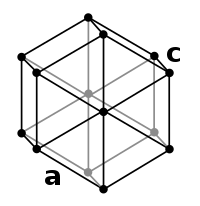
Photo from wikipedia
Hydrothermal processes on Enceladus Saturn's moon Enceladus has a subsurface ocean covered by a layer of ice. Some liquid escapes into space through cracks in the ice, which is the… Click to show full abstract
Hydrothermal processes on Enceladus Saturn's moon Enceladus has a subsurface ocean covered by a layer of ice. Some liquid escapes into space through cracks in the ice, which is the source of one of Saturn's rings. In October 2015, the Cassini spacecraft flew directly through the plume of escaping material and sampled its chemical composition. Waite et al. found that the plume contains molecular hydrogen, H2, a sign that the water in Enceladus' ocean is reacting with rocks through hydrothermal processes (see the Perspective by Seewald). This drives the ocean out of chemical equilibrium, in a similar way to water around Earth's hydrothermal vents, potentially providing a source of chemical energy. Science, this issue p. 155; see also p. 132 Enceladus’ subsurface ocean contains H2, a sign of hydrothermal reactions between rock and water. Saturn’s moon Enceladus has an ice-covered ocean; a plume of material erupts from cracks in the ice. The plume contains chemical signatures of water-rock interaction between the ocean and a rocky core. We used the Ion Neutral Mass Spectrometer onboard the Cassini spacecraft to detect molecular hydrogen in the plume. By using the instrument’s open-source mode, background processes of hydrogen production in the instrument were minimized and quantified, enabling the identification of a statistically significant signal of hydrogen native to Enceladus. We find that the most plausible source of this hydrogen is ongoing hydrothermal reactions of rock containing reduced minerals and organic materials. The relatively high hydrogen abundance in the plume signals thermodynamic disequilibrium that favors the formation of methane from CO2 in Enceladus’ ocean.
Journal Title: Science
Year Published: 2017
Link to full text (if available)
Share on Social Media: Sign Up to like & get
recommendations!